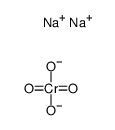Sodium chromate anhydrous

Sodium chromate anhydrous structure
|
Common Name | Sodium chromate anhydrous | ||
|---|---|---|---|---|
| CAS Number | 7775-11-3 | Molecular Weight | 161.97300 | |
| Density | 1.483 | Boiling Point | 392ºC | |
| Molecular Formula | CrNa2O4 | Melting Point | 792ºC | |
| MSDS | Chinese USA | Flash Point | N/A | |
| Symbol |




GHS05, GHS06, GHS08, GHS09 |
Signal Word | Danger | |
| Name | sodium chromate |
|---|---|
| Synonym | More Synonyms |
| Density | 1.483 |
|---|---|
| Boiling Point | 392ºC |
| Melting Point | 792ºC |
| Molecular Formula | CrNa2O4 |
| Molecular Weight | 161.97300 |
| Exact Mass | 161.90000 |
| PSA | 80.26000 |
| Water Solubility | 530 G/L (20 ºC) |
CHEMICAL IDENTIFICATION
HEALTH HAZARD DATAACUTE TOXICITY DATA
MUTATION DATA
|
| Symbol |




GHS05, GHS06, GHS08, GHS09 |
|---|---|
| Signal Word | Danger |
| Hazard Statements | H301-H312-H314-H317-H330-H334-H340-H350-H360FD-H372-H410 |
| Precautionary Statements | P201-P260-P273-P280-P304 + P340 + P310-P305 + P351 + P338 |
| Personal Protective Equipment | Eyeshields;Faceshields;full-face particle respirator type N100 (US);Gloves;respirator cartridge type N100 (US);type P1 (EN143) respirator filter;type P3 (EN 143) respirator cartridges |
| Hazard Codes | T+:Very toxic; N:Dangerous for the environment; |
| Risk Phrases | R21;R25;R26;R34;R42/43;R45;R46;R48/23;R50/53;R60;R61 |
| Safety Phrases | S45-S53-S60-S61 |
| RIDADR | UN 3288 |
| WGK Germany | 3 |
| RTECS | GB2955000 |
| Packaging Group | II |
| Hazard Class | 6.1 |
|
Fc Engineering of Human IgG1 for Altered Binding to the Neonatal Fc Receptor Affects Fc Effector Functions.
J. Immunol. 194 , 5497-508, (2015) Engineering of the constant Fc part of monoclonal human IgG1 (hIgG1) Abs is an approach to improve effector functions and clinical efficacy of next-generation IgG1-based therapeutics. A main focus in ... |
|
|
Human Skin Cells Are More Sensitive than Human Lung Cells to the Cytotoxic and Cell Cycle Arresting Impacts of Particulate and Soluble Hexavalent Chromium.
Biol. Trace Elem. Res. 166 , 49-56, (2015) Hexavalent chromium Cr(VI) is a known human lung carcinogen, with solubility playing an important role in its carcinogenic potency. Dermal exposure to Cr(VI) is common and has been associated with ski... |
|
|
Antibody stabilization of peptide-MHC multimers reveals functional T cells bearing extremely low-affinity TCRs.
J. Immunol. 194(1) , 463-74, (2014) Fluorochrome-conjugated peptide-MHC (pMHC) multimers are commonly used in combination with flow cytometry for direct ex vivo visualization and characterization of Ag-specific T cells, but these reagen... |
| MFCD00003484 |
| EINECS 231-889-5 |
| Sodium chromate |
| disodium,dioxido(dioxo)chromium |